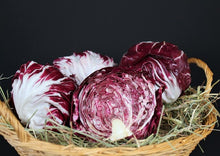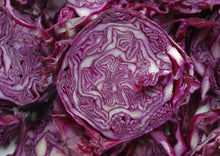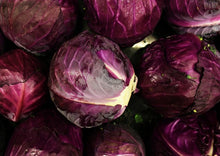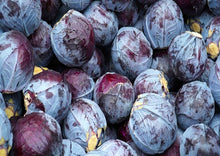Heirloom Red Acre Cabbage is an open-pollinated variety that has a long history of cultivation. The red cabbage comes from the same species as the green cabbage, Brassica oleracea, but it has been selectively bred over time to develop a reddish or purple color. The exact origin of the red cabbage is not known, but it is believed to have been developed in Europe, specifically in the Mediterranean region.
The red cabbage is known for its deep red or purple color, which comes from the presence of pigments called anthocyanins. These pigments are also found in other red or purple fruits and vegetables such as blueberries, blackberries, and red wine. Red cabbage is a rich source of antioxidants and it has a slightly sweeter and milder flavor than green cabbage.
The Red Acre variety is a reliable and productive variety that is well-suited for small gardens and home gardening. It can be planted in the spring or fall, and it's tolerant to cooler temperatures and can withstand frost, which makes it a great option for fall harvests.
Red cabbage is a versatile vegetable that can be eaten raw or cooked, it's packed with vitamins and minerals, such as Vitamin C and K, and it's a low-calorie food. It can be eaten in salads, sautéed, grilled, steamed, or used in soups and stews. It is also commonly used in pickling, fermentation, and sauerkraut.
In summary, Heirloom Red Acre Cabbage is an open-pollinated variety that has a long history of cultivation, it's well-suited for small gardens and home gardening, it's versatile and nutritious, and it's a great addition to any home garden, particularly for the fall harvests.
As a bonus, this plant adds a festive color to the garden as well as in the plates. This packet sows up to 200 SQFT.
Growing
- Understand cabbage is a heavy feeder; it quickly depletes the soil of required nutrients.
- Prepare soil in advance by mixing aged manure or compost. Soil should be well-draining, roots that stand in water cause heads to split or rot.
- Start indoors about 6 to 8 weeks before the last spring frost.
- Before planting the seedlings outdoors, harden off the plants over the course of a week or two.
- Transplant small plants outdoors on a cloudy afternoon 2 to 3 weeks before the last spring frost date.
- Plant seedlings 12 to 24 inches apart in rows, depending on the size of head desired. The closer you plant, the smaller the cabbages.
Care
- When seedlings reach about 5 inches tall, thin to leave the desired space between them.
- Mulch thickly around the area to retain moisture and regulate soil temperature. The optimum soil temperature is about 60 °F to 65 °F. Plants exposed to temperatures below 45°F may form loose heads.
- Fertilize 2 weeks after transplanting with a balanced (10-10-10) fertilizer.
Harvest
- Harvest when heads reach desired size and are firm. Mature heads will split. This will take around 75-90 days for most cabbage varieties.
- To harvest, cut each cabbage head at its base with a sharp knife. Remove any yellow leaves (retain loose green leaves; they provide protection in storage) and immediately bring the head indoors or place it in shade.
- To get two crops, cut the cabbage head out of the plant, leaving the outer leaves and root in the garden. The plant will send up new heads; pinch off those until only four or so smaller heads remain. Harvest when tennis ball-size (perfect for salads!).
- After harvesting, remove the entire stem and root system from the soil to prevent disease. Only compost healthy plants; destroy any if infested.









